You are using an out of date browser. It may not display this or other websites correctly.
You should upgrade or use an alternative browser.
You should upgrade or use an alternative browser.
new cyclone 3000 w mid-drive kit?
- Thread starter emaayan
- Start date
DingusMcGee
100 kW
For adding power venting some modifications over the Ram Air Ventilation motor cap were made. The inlet hole was changed from 1/2" to 3/4" and five 6mm air exit holes were drilled and taped in the right side of the motor case. On this motor cap the 3/4" copper street L was pop riveted to the lid.
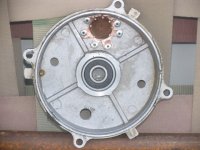
On a 20 mile test ride the Makita Blower DUB 182 [91 cu ft /min & 3 speeds] 18v was used at top blower speed to force air through the 3/4" copper inlet and into the motor case and out the various exit holes with energy supplied from a 6 Ah lithium battery. It is 3.4 miles from my house to the east I -80 entrance and then 1224' elevation gain in the next 6.6 miles to the summit exit. Motor temp at the start of I-80 was 38.9 C. I rode full throttle to the summit exit taking a little over 13 minutes on I - 80 as the winds were against me so top cruise speed was low, around 30 mph instead of 38mph on the Ram & OEM ventalation tests. But the average energy use for the 10 miles of climbing was 80.0 Whr/mi. Today's temperature was at ride time 70 F or about 7.8 C warmer than the day of the OEM ventilation test ride which the max motor temp rose to almost 76 C at the summit. The summit temp for today's ride was 51.8 C at the Summit exit. If you adjust this 51.8 C temperature for site difference linearly for todays higher temp the temp likely would be somewhere 51.8 C - 7.8 C = a mere 44 C max. So one can conclude the power blower makes a big difference over the OEM cooling [fins] [maybe 30 C degrees when running 3200 watts continually] and even over ram ventilation. Amp max was 43.61 amps at say 80 v = 3488 watts. The CA typically read 3200 watts both ways - uphill & downhill. The trip was fully DTH.
Here is pic of the ad hoc setup:
As soon as I summited I took the I-80 entrance west back home at full throttle. Top speed was 62.0 mph. As I had no mirror I could not get off the shoulder and in the right lane to draft a slow truck. Likely the top speed would have been higher if I was able to draft. The motor temp dropped to 47 C going downhill but I was in smallest cassette and same 32T on front chainring as used going uphill while still putting out about 3000 + watts going downhill. I am running an OEM 40 amp Cyclone controller that has no shunt mods or anything of the sorts.
No smoking motor here. What if I had had the Cyclone 60 am programmable controller that was sitting home in a box? No problem for the MultiStar 20 s 32ah battery set up. The 20 mile ride consumed 17.6 ah.

On a 20 mile test ride the Makita Blower DUB 182 [91 cu ft /min & 3 speeds] 18v was used at top blower speed to force air through the 3/4" copper inlet and into the motor case and out the various exit holes with energy supplied from a 6 Ah lithium battery. It is 3.4 miles from my house to the east I -80 entrance and then 1224' elevation gain in the next 6.6 miles to the summit exit. Motor temp at the start of I-80 was 38.9 C. I rode full throttle to the summit exit taking a little over 13 minutes on I - 80 as the winds were against me so top cruise speed was low, around 30 mph instead of 38mph on the Ram & OEM ventalation tests. But the average energy use for the 10 miles of climbing was 80.0 Whr/mi. Today's temperature was at ride time 70 F or about 7.8 C warmer than the day of the OEM ventilation test ride which the max motor temp rose to almost 76 C at the summit. The summit temp for today's ride was 51.8 C at the Summit exit. If you adjust this 51.8 C temperature for site difference linearly for todays higher temp the temp likely would be somewhere 51.8 C - 7.8 C = a mere 44 C max. So one can conclude the power blower makes a big difference over the OEM cooling [fins] [maybe 30 C degrees when running 3200 watts continually] and even over ram ventilation. Amp max was 43.61 amps at say 80 v = 3488 watts. The CA typically read 3200 watts both ways - uphill & downhill. The trip was fully DTH.
Here is pic of the ad hoc setup:
As soon as I summited I took the I-80 entrance west back home at full throttle. Top speed was 62.0 mph. As I had no mirror I could not get off the shoulder and in the right lane to draft a slow truck. Likely the top speed would have been higher if I was able to draft. The motor temp dropped to 47 C going downhill but I was in smallest cassette and same 32T on front chainring as used going uphill while still putting out about 3000 + watts going downhill. I am running an OEM 40 amp Cyclone controller that has no shunt mods or anything of the sorts.
No smoking motor here. What if I had had the Cyclone 60 am programmable controller that was sitting home in a box? No problem for the MultiStar 20 s 32ah battery set up. The 20 mile ride consumed 17.6 ah.
What temperatures did you get up to before you installed the blower? I stop and let my Cyclone cool when it reaches 110C. Which is what Justin at Grin Tech recommended. So far so good.
Do you think that drilling holes in the side plate would help significantly?
BTW: I have been running my BBSHD up to 110C and I recently melted the nylon gear.
Do you think that drilling holes in the side plate would help significantly?
BTW: I have been running my BBSHD up to 110C and I recently melted the nylon gear.
Just a noob here, but I know a thing or two about EV's.
I assume you guys are measuring stator temps with some sort of stick on probe.
Nice! I will be doing the same for my motor and battery pack, after I get the kit up and running, after it arrives.
Pulled the trigger yesterday ! (500W mid-rive / 48V - 17.5Ah batt.)
(500W mid-rive / 48V - 17.5Ah batt.)
What some people don't realize is the Stator is one part of the energy flow.
The Rotor, with its little rare earth magnets, is the other part. And those magnets get HOT doing the the work of making mechanical energy.
The magnets get hot, the whole rotor gets hot, and the shaft with the gears touching the plastic gear is also very hot, obviously,,,, and plastics have lower limits....
Anytime a 3-ph brushless or stepper motor is making its rated power the rotor is as hot as the stator, if not hotter.
And really high temps are one of the things that can hurt the magnets. Get them hot enough and they lose some of their magnetism. Your motor will never produce high power again, no matter how much power you pump into the stator
Anytime you overdrive a system beyond what it was engineered to do,,, well,, chit happens.
But this chit is cheap and fun to dik with!!
I assume you guys are measuring stator temps with some sort of stick on probe.
Nice! I will be doing the same for my motor and battery pack, after I get the kit up and running, after it arrives.
Pulled the trigger yesterday !
What some people don't realize is the Stator is one part of the energy flow.
The Rotor, with its little rare earth magnets, is the other part. And those magnets get HOT doing the the work of making mechanical energy.
The magnets get hot, the whole rotor gets hot, and the shaft with the gears touching the plastic gear is also very hot, obviously,,,, and plastics have lower limits....
Anytime a 3-ph brushless or stepper motor is making its rated power the rotor is as hot as the stator, if not hotter.
And really high temps are one of the things that can hurt the magnets. Get them hot enough and they lose some of their magnetism. Your motor will never produce high power again, no matter how much power you pump into the stator
Anytime you overdrive a system beyond what it was engineered to do,,, well,, chit happens.
But this chit is cheap and fun to dik with!!
DingusMcGee
100 kW
Norton,
I cannot find any research to back your claim of equivalence as stated above. But I have found plenty of research to say that there are obvious Hot Spots in PM motors and they are not at the PM's.
in addition to now citing this research on PM motor hot spots below, you can find other research backed studies of motor hot spots cited earlier by Dingus McGee in this same thread.
https://chargedevs.com/features/lord-corporation-builds-on-its-work-potting-electric-motors-reducing-hot-spots-by-up-to-40/
I did place the Kelly thermistor in the end windings of one coil and I have observed that the most intensely burned zone of a burned up C-3000 motor was in the end windings that were overlain with the phase wires. This burned out motor still had PMs that were as strong as new ones. I put these PM in a pressure cooker and got them to a uniform temp of about 124 C and still no degradation in PM strength.
Anytime a 3-ph brushless or stepper motor is making its rated power the rotor is as hot as the stator, if not hotter.
I cannot find any research to back your claim of equivalence as stated above. But I have found plenty of research to say that there are obvious Hot Spots in PM motors and they are not at the PM's.
in addition to now citing this research on PM motor hot spots below, you can find other research backed studies of motor hot spots cited earlier by Dingus McGee in this same thread.
https://chargedevs.com/features/lord-corporation-builds-on-its-work-potting-electric-motors-reducing-hot-spots-by-up-to-40/
In general, the end windings are considered to be a problem hot spot, and if you can get the heat away from the windings, you can reduce the overall temperature as well.
I did place the Kelly thermistor in the end windings of one coil and I have observed that the most intensely burned zone of a burned up C-3000 motor was in the end windings that were overlain with the phase wires. This burned out motor still had PMs that were as strong as new ones. I put these PM in a pressure cooker and got them to a uniform temp of about 124 C and still no degradation in PM strength.
DingusMcGee
100 kW
Sather,
Since I did not do the run with OEM fins [only] cooling only on the same day as the blower cooled motor I had to correct for blower cooled day that was 7.8 C warmer than on the day of the OEM cooling test was done. On the day I did the blower test the summit temp was 51.8 C and if I had done the OEM cooling on that day it likely would have been 83.8 C.
I'll bet you could not get your setup to 110 C with the blower cooled motor unless maybe you did the 3000'? climb out of Death Valley when the ambient temp was 118 F. On those situations where you get the motor temp to 110 C you would likely be seeing about 80C with a blower cooled motor. Or looking at the power cooling effect in another way you could run more amps & watts before getting to steady state 110 C.
I suspect just drilling holes in the left plate will not produce near as much heat removal as adding the elbow that makes for getting some ram air cooling. You have to force the hot air out of the motor case.
But keep this idea in mind: Ram air cooling works only at high speeds and blower assisted cooling works at any speed.
What temperatures did you get up to before you installed the blower? I stop and let my Cyclone cool when it reaches 110C. Which is what Justin at Grin Tech recommended. So far so good.
Do you think that drilling holes in the side plate would help significantly?
Since I did not do the run with OEM fins [only] cooling only on the same day as the blower cooled motor I had to correct for blower cooled day that was 7.8 C warmer than on the day of the OEM cooling test was done. On the day I did the blower test the summit temp was 51.8 C and if I had done the OEM cooling on that day it likely would have been 83.8 C.
I'll bet you could not get your setup to 110 C with the blower cooled motor unless maybe you did the 3000'? climb out of Death Valley when the ambient temp was 118 F. On those situations where you get the motor temp to 110 C you would likely be seeing about 80C with a blower cooled motor. Or looking at the power cooling effect in another way you could run more amps & watts before getting to steady state 110 C.
I suspect just drilling holes in the left plate will not produce near as much heat removal as adding the elbow that makes for getting some ram air cooling. You have to force the hot air out of the motor case.
But keep this idea in mind: Ram air cooling works only at high speeds and blower assisted cooling works at any speed.
An update on my install.
I've pretty much finished the motor mount.
I made this plastic block to prevent the motor rotating upward under power.
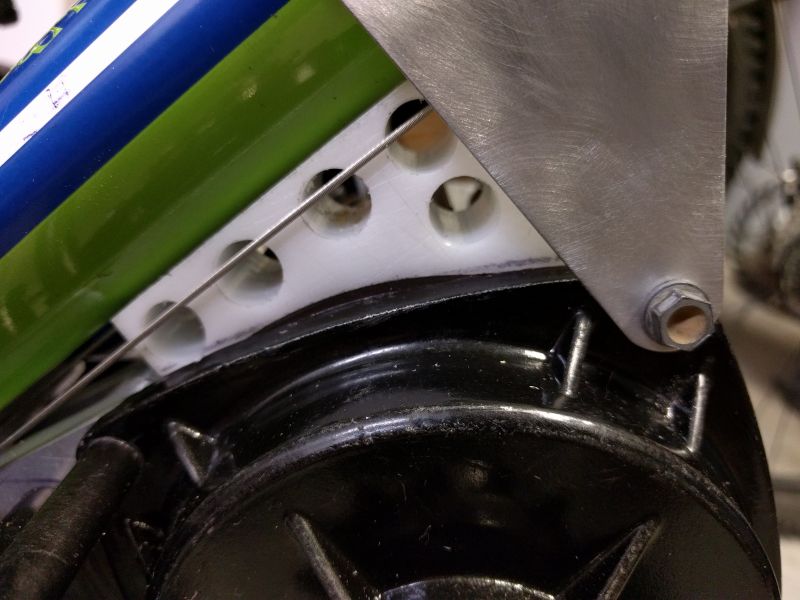
And I made this strap to prevent the motor rotating down when hitting bumps.
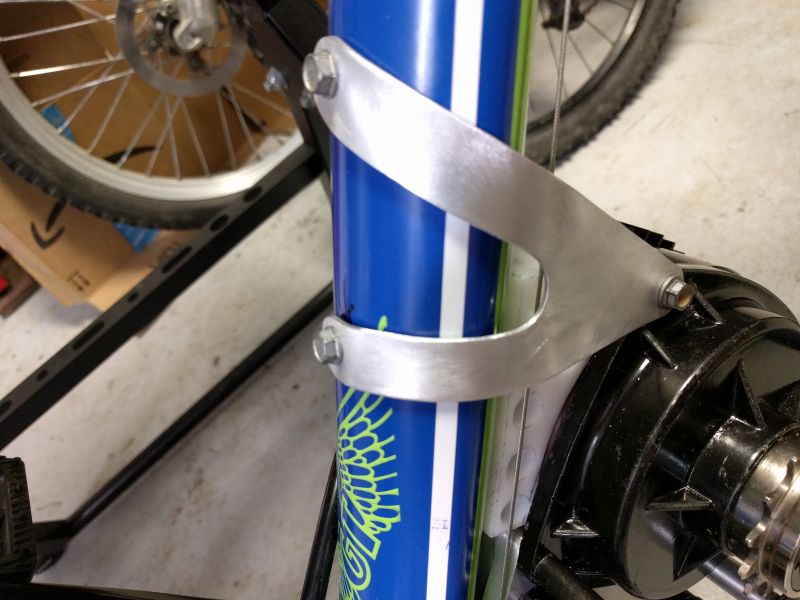
I've also built my controller mount.
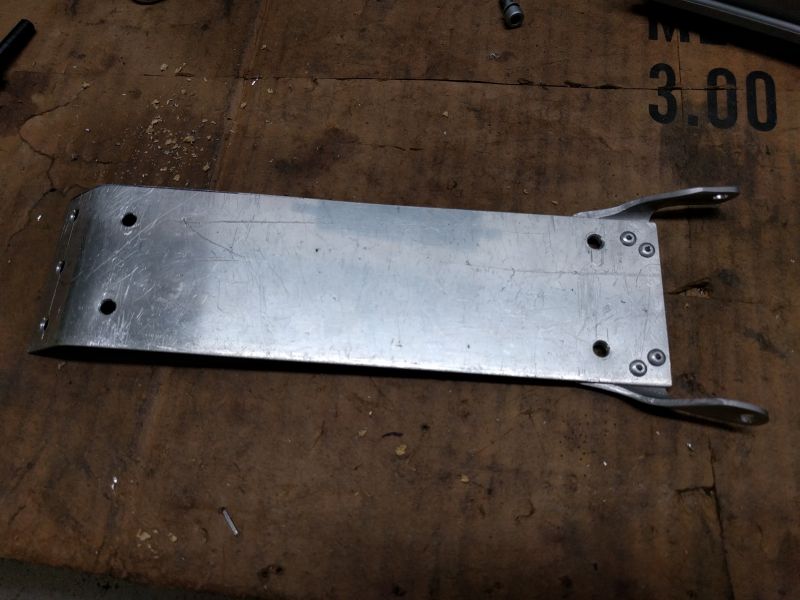
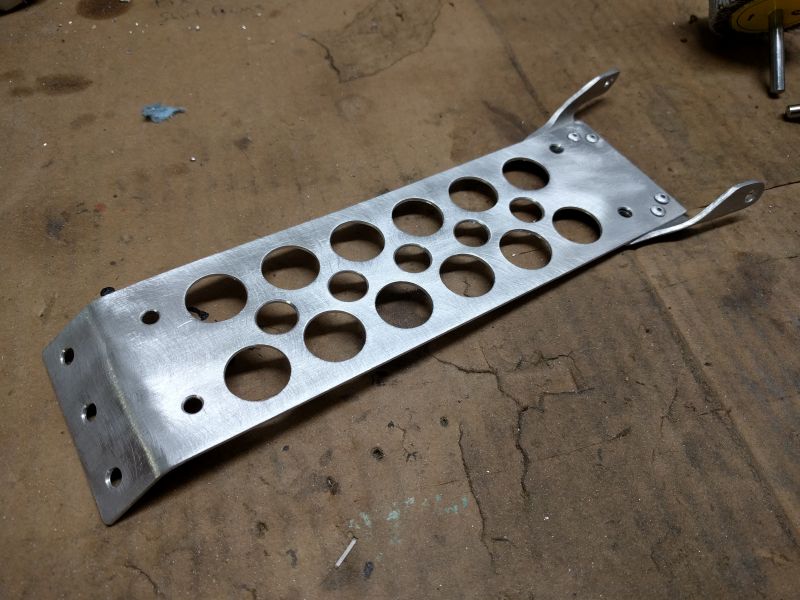
I replaced the rack bracket with the mount. I think it is pretty well integrated in that spot. It has good airflow, and the wiring passes through between the seat stays, so it will help prevent the wiring from being too eye catching.
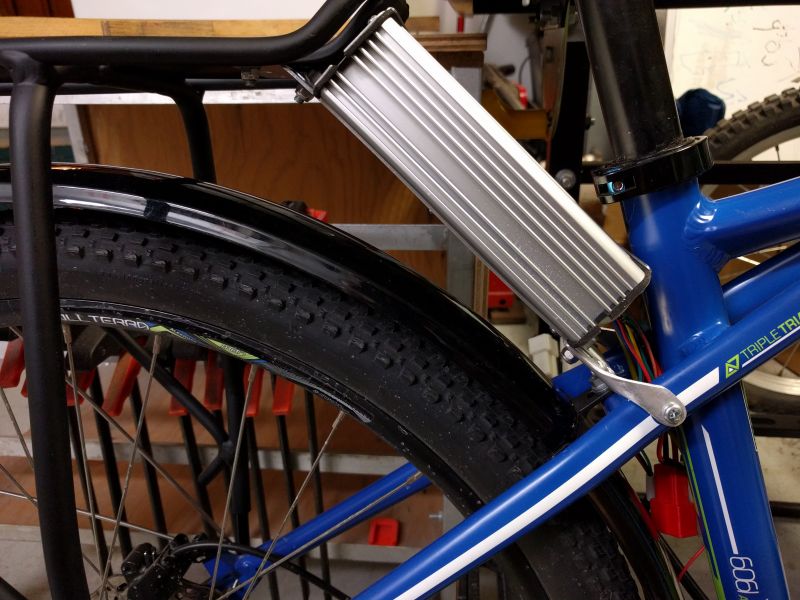
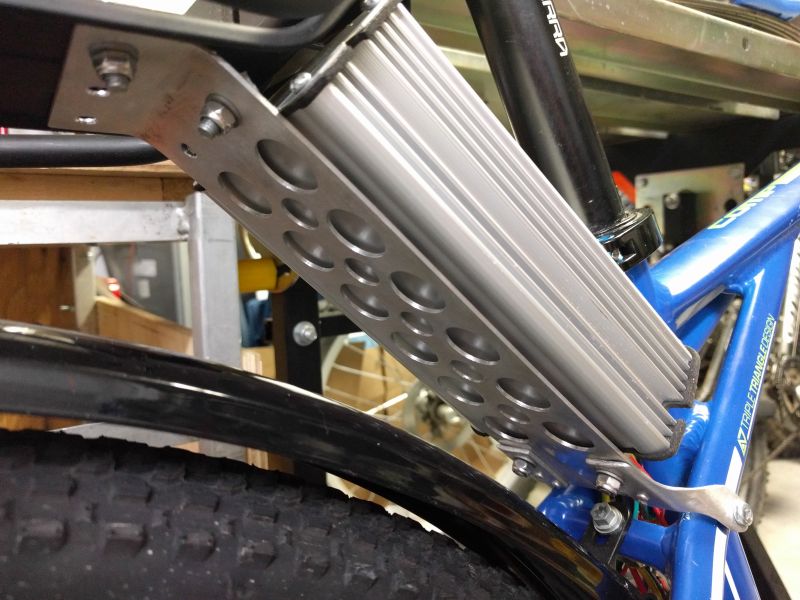
Yes, I am missing fasteners. I didn't have enough M5 hardware, so I will have to order some. Once I am finished with all the prototyping, then I will order hardware.
Also, I learned a lesson about battery safety. I was mocking up the battery location in the triangle when the charge connector brushed against the sprocket. There was a tremendous flash, and the charge connector got burnt, and one of the sprocket teeth got ruined. I should be able to save the sprocket with some careful file work. Now the battery connectors are bagged, and I have to order new XT60 connectors.
Notice the tooth with the gold material from the connector welded to it.
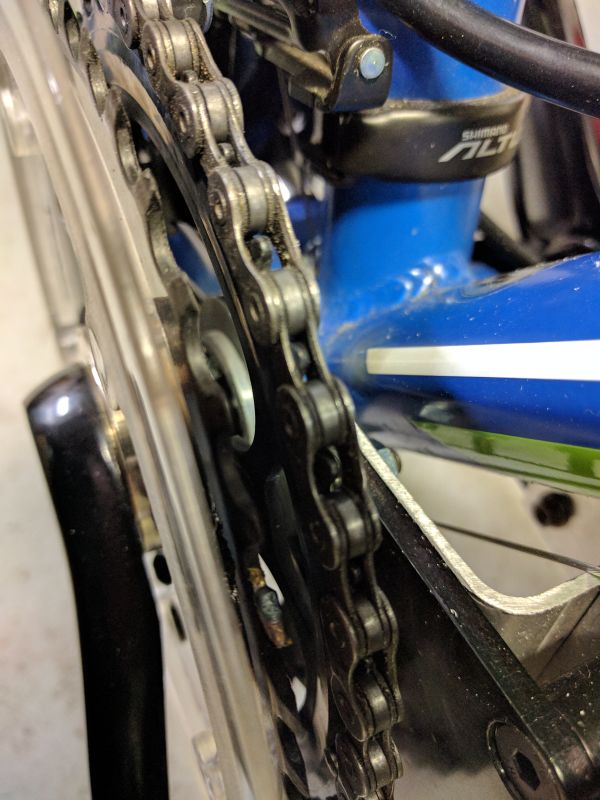
I've pretty much finished the motor mount.
I made this plastic block to prevent the motor rotating upward under power.

And I made this strap to prevent the motor rotating down when hitting bumps.

I've also built my controller mount.


I replaced the rack bracket with the mount. I think it is pretty well integrated in that spot. It has good airflow, and the wiring passes through between the seat stays, so it will help prevent the wiring from being too eye catching.


Yes, I am missing fasteners. I didn't have enough M5 hardware, so I will have to order some. Once I am finished with all the prototyping, then I will order hardware.
Also, I learned a lesson about battery safety. I was mocking up the battery location in the triangle when the charge connector brushed against the sprocket. There was a tremendous flash, and the charge connector got burnt, and one of the sprocket teeth got ruined. I should be able to save the sprocket with some careful file work. Now the battery connectors are bagged, and I have to order new XT60 connectors.
Notice the tooth with the gold material from the connector welded to it.

This is a very well known fact about magnets. Try again.DingusMcGee said:Norton,
..I cannot find any research to back your claim of equivalence as stated above. .... This burned out motor still had PMs that were as strong as new ones. I put these PM in a pressure cooker and got them to a uniform temp of about 124 C and still no degradation in PM strength.
I found this easily: https://www.apexmagnets.com/faq#will_neodymium_magnets_demagnetize_if_heat
"Will Neodymium magnets demagnetize if I heat them?
Yes, if heated beyond 176 degrees Fahrenheit (80 degrees Celsius) the magnets will quickly loose their magnetic properties."
How did you measure this test of strength? How did you get to 124°C? With water in the pressure cooker? What are the magnets made from in these bigass motors?
I'm not arguing, it's just that if that pinion gear on the motor shaft is melting the plastic drive gear, that heat came from the PM's themselves.
I'm not discouraging 'Hot Rodding' electric motors. But there are limits. Forced cooling is a great idea! But,,,why not just buy a big motor to begin with?
Ding,DingusMcGee said:...in addition to now citing this research on PM motor hot spots below, you can find other research backed studies of motor hot spots cited earlier by Dingus McGee in this same thread.
https://chargedevs.com/features/lord-corporation-builds-on-its-work-potting-electric-motors-reducing-hot-spots-by-up-to-40/
....In general, the end windings are considered to be a problem hot spot, and if you can get the heat away from the windings, you can reduce the overall temperature as well.
This -> highly thermally conductive, electrically insulating silicone material, Thermoset SC-320 - sounds like good stuff to help with hotrodding and existing motor design. Combine that with a thermal compound between external cooling fins on the outside of a motor case and you could pull a lot of heat away from the stator.
BUT, the PM's are still dealing with all that Wattage also. Forced air cooling may still be needed with some motors.
Of course, oil cooling with an external heat exchanger is the ultimate way to design an EV motor.
My daily driver is built this way.
Good article here...
https://chargedevs.com/features/lord-corporation-builds-on-its-work-potting-electric-motors-reducing-hot-spots-by-up-to-40/
Looks like it comes in epoxy and silicone types.
How does one pot or immerse a motor?
DingusMcgee, is the blower permanent or just to test it out? The noise would annoy me so I wouldn't attempt that mod myself.
https://chargedevs.com/features/lord-corporation-builds-on-its-work-potting-electric-motors-reducing-hot-spots-by-up-to-40/
Looks like it comes in epoxy and silicone types.
How does one pot or immerse a motor?
DingusMcgee, is the blower permanent or just to test it out? The noise would annoy me so I wouldn't attempt that mod myself.
DingusMcGee
100 kW
Norton said,
If you have not read this post please do so:
https://endless-sphere.com/forums/viewtopic.php?f=28&t=69867&start=1900#p1266139
We here know these bike motors continue to work quite well after measuring temps as high as 110 C = 230 F which is 54 F degrees higher than your article claims. I also have a Cromotor Hubzilla and it operates faultlessly up to 125C and maybe more since I do not know if where the thermistors are placed is the hottest spot in the motor.
The low Currie rating you & your story suggest does not even show up in the table of neodymium magnets from e Magnets UK. See:
http://e-magnetsuk.com/neodymium_magnets/temperature_ratings.aspx
Features of neodymium magnets
Temperature type Max. working temperature Curie temperature
SH 150°C 340°C
UH 180°C 350°C
EH 200°C 350°C
AH 230°C 350°C
3 more rows
If we assume the neodymium PMs on the C-3000 have the lowest rated Curie temp of grade SH we would have 150 C = 302 F.
The strength was measured using a calibrated load cell pulling axially with an electric winch on the gear case which is attached to the rotor [held by a split ring]. The stator was anchored to the floor. One would think a weaker set of rotor PMs would pull out of the stator easier than a set having the original OEM strength. Or are you saying that even though they pull out equally hard they are weaker because they have been heated? NONSENSE
As I have heated these C-3000 magnets in a heated pressure cooker to at least 121C = 250 F and they showed no loss of strength so they are not likely type H which degrades 120 C = 248 F.
That is exactly what I did. I purchased the Cromotor Hubzilla [It can take maybe 10 kw] at least a year before buying the C-3000. Big motors weight more; big motor cost more; big motors do not fit in as small of space; big motors have higher moments of inertia. And on and on....
Big motors simply are not the solution to every problem little motors create.
This is a very well known fact about magnets. Try again.
I found this easily: https://www.apexmagnets.com/faq#will_neodymium_magnets_demagnetize_if_heat
"Will Neodymium magnets demagnetize if I heat them?
Yes, if heated beyond 176 degrees Fahrenheit (80 degrees Celsius) the magnets will quickly loose their magnetic properties."
If you have not read this post please do so:
https://endless-sphere.com/forums/viewtopic.php?f=28&t=69867&start=1900#p1266139
We here know these bike motors continue to work quite well after measuring temps as high as 110 C = 230 F which is 54 F degrees higher than your article claims. I also have a Cromotor Hubzilla and it operates faultlessly up to 125C and maybe more since I do not know if where the thermistors are placed is the hottest spot in the motor.
The low Currie rating you & your story suggest does not even show up in the table of neodymium magnets from e Magnets UK. See:
http://e-magnetsuk.com/neodymium_magnets/temperature_ratings.aspx
Features of neodymium magnets
Temperature type Max. working temperature Curie temperature
SH 150°C 340°C
UH 180°C 350°C
EH 200°C 350°C
AH 230°C 350°C
3 more rows
If we assume the neodymium PMs on the C-3000 have the lowest rated Curie temp of grade SH we would have 150 C = 302 F.
How did you measure this test of strength?
The strength was measured using a calibrated load cell pulling axially with an electric winch on the gear case which is attached to the rotor [held by a split ring]. The stator was anchored to the floor. One would think a weaker set of rotor PMs would pull out of the stator easier than a set having the original OEM strength. Or are you saying that even though they pull out equally hard they are weaker because they have been heated? NONSENSE
As I have heated these C-3000 magnets in a heated pressure cooker to at least 121C = 250 F and they showed no loss of strength so they are not likely type H which degrades 120 C = 248 F.
But,,,why not just buy a big motor to begin with?
That is exactly what I did. I purchased the Cromotor Hubzilla [It can take maybe 10 kw] at least a year before buying the C-3000. Big motors weight more; big motor cost more; big motors do not fit in as small of space; big motors have higher moments of inertia. And on and on....
Big motors simply are not the solution to every problem little motors create.
DingusMcGee
100 kW
Skaiwerd,
The blower is not a permanent fixture but it could be put on again. Some years ago I was planing on entering the Pikes Peak ebike Race [now discontinued?] with some modifications to force air through a hub motor using a close fitting pan lid on the left side for forced air entry through holes in the rotating left case and visible hoses in the motor case on the right side for exiting hot air. The goal was to beat the Omnibike and get the reward $$. I had already had success using forced air blower cooling of welders to get them to weld longer and hotter. I was working on too close of a dateline to have the finished hub motor cooler for race day.
But such cooling has its advantages over motor poting in that once you pot the motor the conduction rate is fixed but with air cooling you can always increase the air speed and with baffling and get more cooling.
As for the noise: At 62 mph you do not hear the blower.
DingusMcgee, is the blower permanent or just to test it out? The noise would annoy me so I wouldn't attempt that mod myself
The blower is not a permanent fixture but it could be put on again. Some years ago I was planing on entering the Pikes Peak ebike Race [now discontinued?] with some modifications to force air through a hub motor using a close fitting pan lid on the left side for forced air entry through holes in the rotating left case and visible hoses in the motor case on the right side for exiting hot air. The goal was to beat the Omnibike and get the reward $$. I had already had success using forced air blower cooling of welders to get them to weld longer and hotter. I was working on too close of a dateline to have the finished hub motor cooler for race day.
But such cooling has its advantages over motor poting in that once you pot the motor the conduction rate is fixed but with air cooling you can always increase the air speed and with baffling and get more cooling.
As for the noise: At 62 mph you do not hear the blower.
DingusMcGee
100 kW
Norton,
You say
Wattage doen't mean crap! It is exceeding the Curie temperature that degrades the magnets. As long as magnets are cooled enough to not exceed their Curie rating they are not bothered by more wattage.
These BLDC motors see efficiency going down as the current increases. see thevenin equivalent circuit for max motor output. As you put more and more amps to these motors they put out a higher percentage of heat as the amps increase.
You say
BUT, the PM's are still dealing with all that Wattage also.
Wattage doen't mean crap! It is exceeding the Curie temperature that degrades the magnets. As long as magnets are cooled enough to not exceed their Curie rating they are not bothered by more wattage.
These BLDC motors see efficiency going down as the current increases. see thevenin equivalent circuit for max motor output. As you put more and more amps to these motors they put out a higher percentage of heat as the amps increase.
DingusMcGee
100 kW
Of course, oil cooling with an external heat exchanger is the ultimate way to design an EV motor.
Ultimate Way? Great assumption, When an oil line breaks or the seals fail you have an oil spill and environmental cleanup not to mention immediate problems. What a CROCK.
I'm just saying that's the way the Big EV's play. (oil cooling)DingusMcGee said:Of course, oil cooling with an external heat exchanger is the ultimate way to design an EV motor.
Ultimate Way? Great assumption, When an oil line breaks or the seals fail you have an oil spill and environmental cleanup not to mention immediate problems. What a CROCK.
But then they have to make an EV last at least to the 100k mile warranty, and the motors are not 'Hot Rodded' until something breaks,, the way E-bikes Hot Rodders play.
Awesome report on the burnt C-3000 motor! You understand the issues and technical testing.
I love bike
1 µW
- Joined
- Jun 2, 2017
- Messages
- 4
Anyone install this kit on a road bike?
If so, what kind of throttles and where to put it?
If so, what kind of throttles and where to put it?
I love bike said:Anyone install this kit on a road bike?
If so, what kind of throttles and where to put it?
I would think a thumb throttle would work...
I can tell you, it would have been easier for me if my frame tubes weren't ovalized...
I was wondering how would cy3k compare to similar power dd hub motor, performance wise, if both are fed with same amps and volts?
For example both systems would have been designed for top speed 30mph @ 40a, 72v
Which one would accelerate quicker? maintain top speed more efficiently?
For example both systems would have been designed for top speed 30mph @ 40a, 72v
Which one would accelerate quicker? maintain top speed more efficiently?
The continuing nuggets bike build...
I got busy with the lathe this morning to make a few spacers. All for the motor mount.
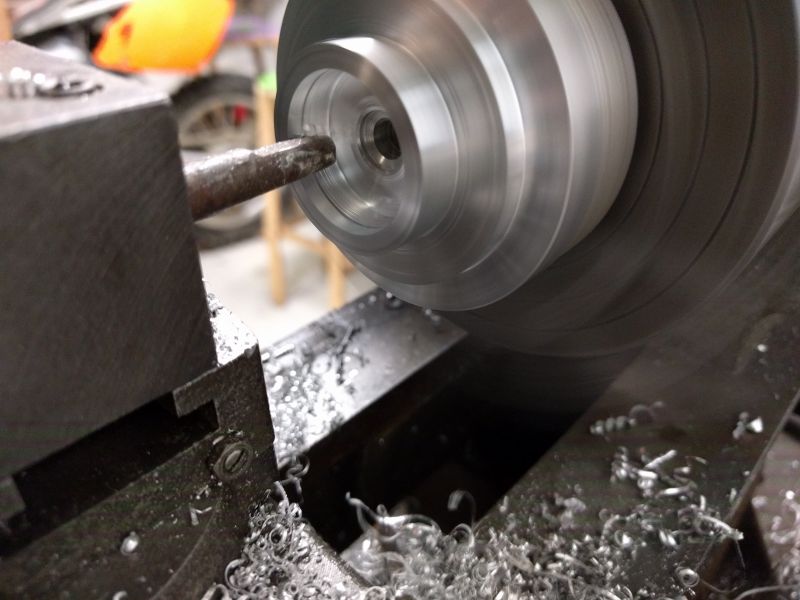
First I cut a spacer for the bottom bracket. I was having an issue where the bearings could move side to side inside the bottom bracket, so I cut a spacer to make the outside bearing stay in place.
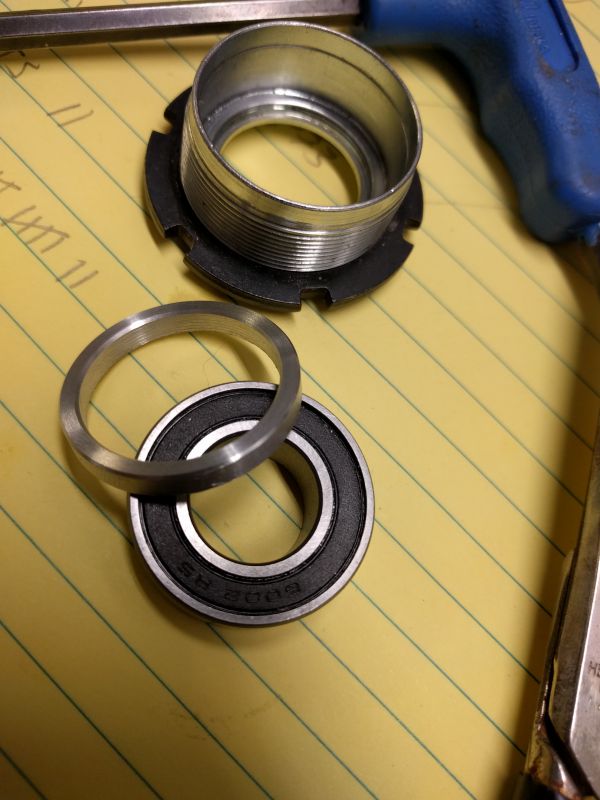
This spacer really did a nice job of making the bottom bracket feel solid. It spins nicely, and doesn't have any play in it now.
Next I cut a couple of spacers so that I can replace the weird 4 bolt setup on the motor mount with two long and strong through bolts. Here's all the spacers.
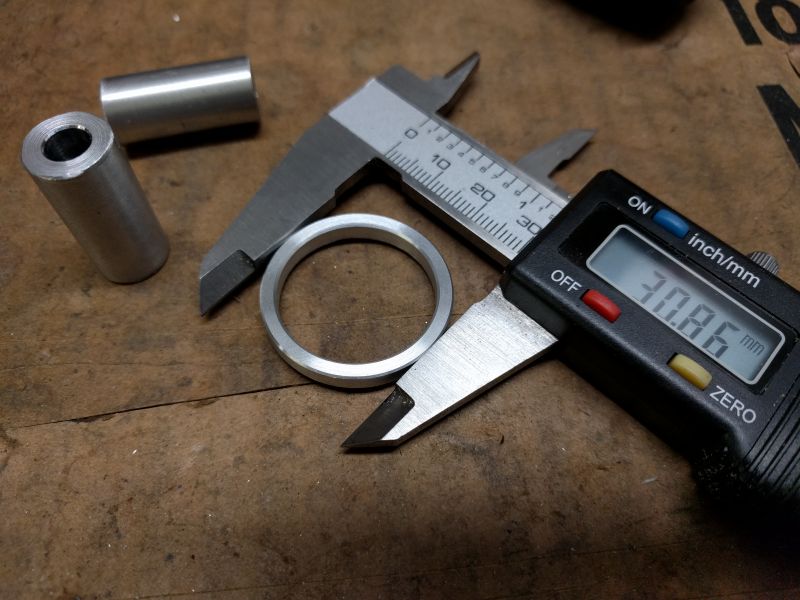
The long spacers will replace this threaded piece... See how I have set the spacer there.
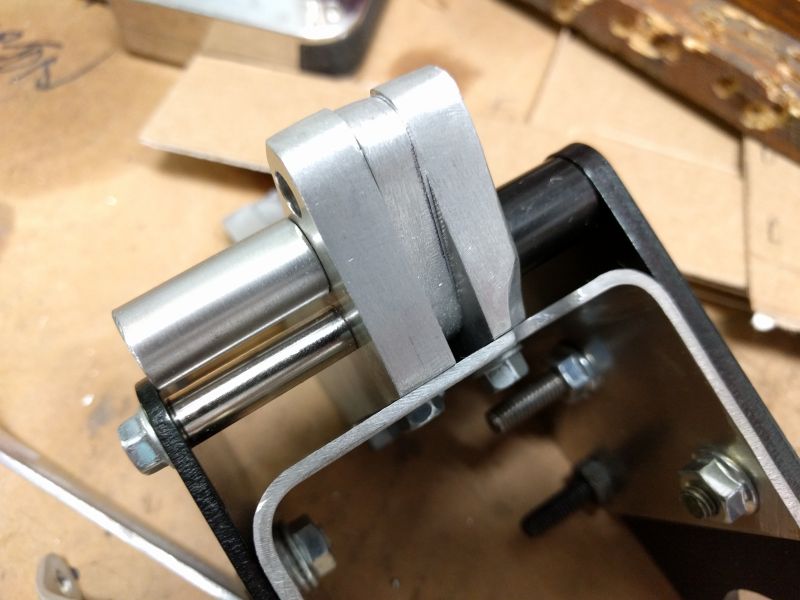
I ordered a 2' x 4' kydex sheet to use to build the battery box. While I am waiting for that, I put it all back together, and put the battery bag on the bike. Then I took it for a shakedown ride to the local singletrack. I figured the rooty track would quickly suss out any issues.
The battery bag sucks since it doesn't fit the frame well, and lets the battery bounce around too much. It would be a great bag for a larger frame, or for riding on the street. Other than that, the rest of the bike was solid. It could use a bit more brake though. Even with the larger front rotor and hydraulic brakes, it felt a bit manic at times. Of course, when you twist the throttle, the thing takes right off.
The exposure went nuts on this photo...
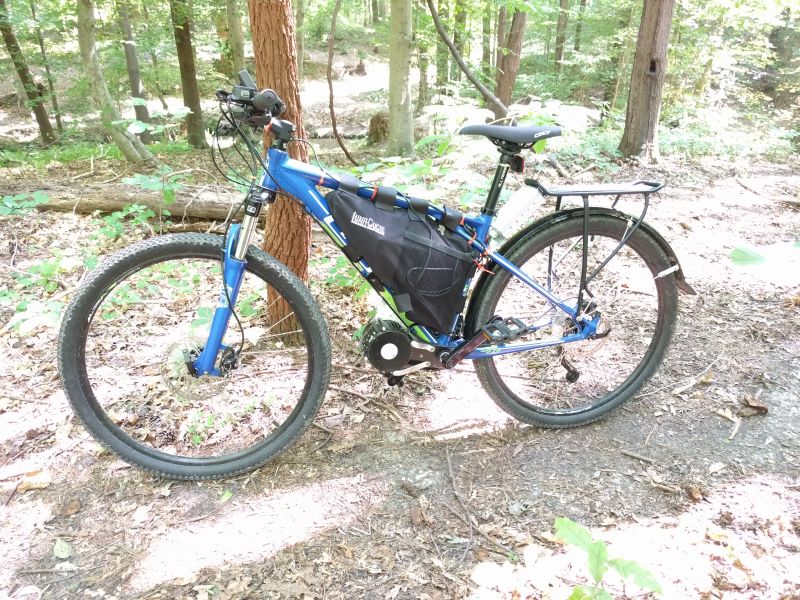
You can see the outline of the battery in the bag. It was just flopping around the whole time.
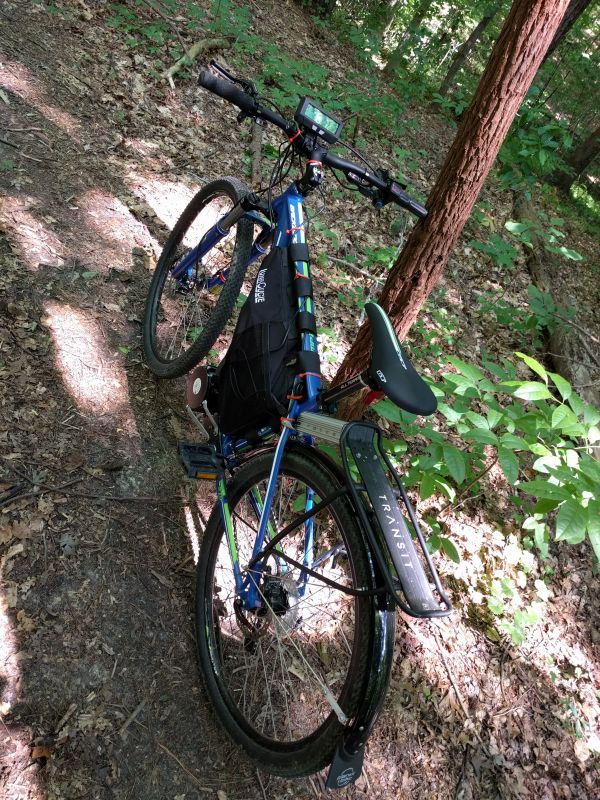
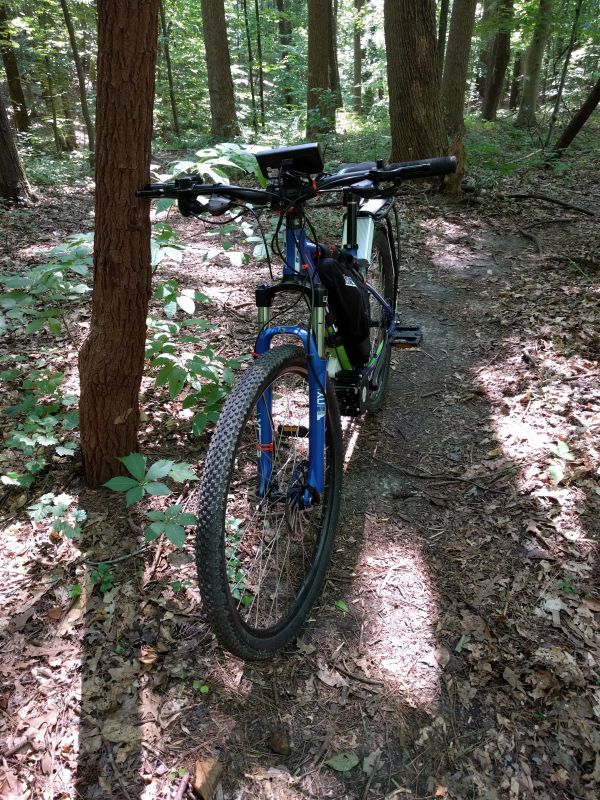
The bike handles well, even with the extra weight. I spent some time showing another biker around the trail system, so I did just pedal it for a few miles, and it does surprisingly well just pedaling along. I did nearly whiskey throttle the thing into a tree, but otherwise avoided any trouble. When I stopped to check the controller and the battery, they didn't feel hot, but the motor does get hot to the touch.
I maxxed it out at 39MPH on the surface streets, and was hanging nicely with 35MPH speed limit traffic.

When on the gas, the thing feels like a light weight dirt bike. It's got tons of torque, and is a bit scary on the MTB trails, so I'm happy.
I got busy with the lathe this morning to make a few spacers. All for the motor mount.

First I cut a spacer for the bottom bracket. I was having an issue where the bearings could move side to side inside the bottom bracket, so I cut a spacer to make the outside bearing stay in place.

This spacer really did a nice job of making the bottom bracket feel solid. It spins nicely, and doesn't have any play in it now.
Next I cut a couple of spacers so that I can replace the weird 4 bolt setup on the motor mount with two long and strong through bolts. Here's all the spacers.

The long spacers will replace this threaded piece... See how I have set the spacer there.

I ordered a 2' x 4' kydex sheet to use to build the battery box. While I am waiting for that, I put it all back together, and put the battery bag on the bike. Then I took it for a shakedown ride to the local singletrack. I figured the rooty track would quickly suss out any issues.
The battery bag sucks since it doesn't fit the frame well, and lets the battery bounce around too much. It would be a great bag for a larger frame, or for riding on the street. Other than that, the rest of the bike was solid. It could use a bit more brake though. Even with the larger front rotor and hydraulic brakes, it felt a bit manic at times. Of course, when you twist the throttle, the thing takes right off.
The exposure went nuts on this photo...

You can see the outline of the battery in the bag. It was just flopping around the whole time.


The bike handles well, even with the extra weight. I spent some time showing another biker around the trail system, so I did just pedal it for a few miles, and it does surprisingly well just pedaling along. I did nearly whiskey throttle the thing into a tree, but otherwise avoided any trouble. When I stopped to check the controller and the battery, they didn't feel hot, but the motor does get hot to the touch.
I maxxed it out at 39MPH on the surface streets, and was hanging nicely with 35MPH speed limit traffic.

When on the gas, the thing feels like a light weight dirt bike. It's got tons of torque, and is a bit scary on the MTB trails, so I'm happy.
CobraJet said:What controller and display is this?
It's the controller that comes with the Cyclone kit, and I'm using a Cycle Analyst for the display. You have to hack the controller for the CA to work, unless you get the CA with stand alone shunt. If doing again, I'd go with the stand alone shunt.
tikivic
1 W
Nuggets - Nice custom parts!....I really like them!
Similar threads
- Replies
- 3
- Views
- 374
- Replies
- 5
- Views
- 1,261
- Replies
- 4
- Views
- 1,503
- Replies
- 1
- Views
- 2,109
- Replies
- 12
- Views
- 2,165


